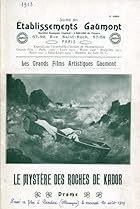Change Your Image

Gerry518
Reviews
Le mystère des roches de Kador (1912)
An Engaging Crime Story
I recently had a chance to view "The Mystery of the Rocks of Kador", directed by Leonce Perret. It's one of the selections on the Gaumont Treasures DVD from Kino, and I believe that it was virtually unseen in the United States before now. Having some familiarity with movies from the early 1900's, I was still surprised by the level of sophistication that Perret brings to this film. It's an engaging four-reel crime story with a very satisfying resolution.
Perret plays the villain - a gentleman willing to do away with his cousin Suzanne and her lover in order to get his hands on her inheritance. It's interesting to see how the villain commits his crime, but the real charm of this movie is the "film within a film" that is used for psychological effect. I would never have expected this in a movie made in 1912. You have to see it to believe it.
Perret does a fine job as both actor and director. Some of the other acting is a bit over-wrought, but the story's pacing kept me entertained throughout. If you are familiar with other dramas of this period (works by D.W. Griffith or Urban Gad, for instance), you may want to see "The Mystery of the Rocks of Kador". You may be as surprised as I was.
L'enfant de Paris (1913)
A Captivating Treasure
What a shame that the films of Leonce Perret are so little known in the United States! Having just seen a crisply restored version of "L'enfant de Paris" (The Child of Paris), I am now eager to see more Perret films. The Kino version of "L'enfant de Paris", at 16 frames per second, runs just over two hours long, and is captivating from beginning to end.
The story centers around a young girl who suffers the loss of both parents. Coming from a family of means, the little girl is sent to an exclusive, but strict, boarding school. After a few unhappy experiences at the school, the girl escapes, only to land in the care of a dangerous thief and a drunken cobbler. A young hunchback who works for the cobbler (young Bosco) befriends the little girl and shows her some much-needed compassion. With amazing delicacy, the story begins to focus as much on Bosco as the little girl - two children of Paris, two outcasts.
The film is epic. Many scenes were shot on location in Paris and Nice. These cities, from a century ago, are fascinating enough, but the direction by Perret is outstanding. He employs low angle and high angle shots, tracking shots and moody back lighting. Some scenes are surprisingly tense; others are wonderfully tender. The story is constructed with sophistication. The acting is generally quite subdued and realistic - very palatable for our modern tastes.
You may think that a pre-WWI film with somewhat Dickensian characters and child protagonist would be too melodramatic to be enjoyable. I found the opposite to be true; I loved this exciting early-twentieth-century slice of life. Even though this is a very old movie, I enjoyed this as much as any contemporary feature length film. If you've sampled some silent cinema and are interested in seeing another high-quality example, check out "L'enfant de Paris" on the Gaumont Treasures DVD from Kino.

